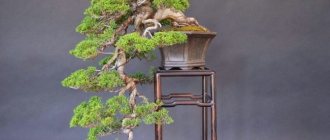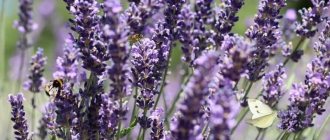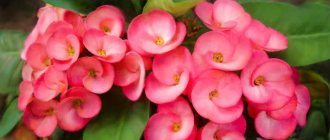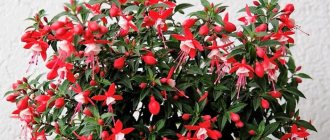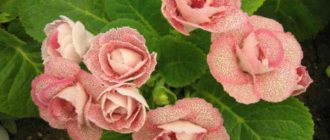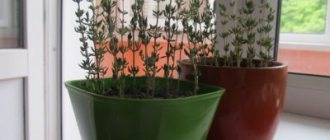- October 15, 2018
- Houseplants
- Natalia Michaelis
Callisia fragrant (popularly called golden mustache) is a houseplant that has healing properties, since its leaves and shoots contain phytosterols and flavonoids. Growing a golden mustache at home is not a particularly difficult task, but you still need to follow some recommendations and rules, which will be described below.
This plant is native to South America. The culture is called golden mustache due to the fact that it has a special leaf structure, which is penetrated by golden threads of vessels. Long shoots are called mustaches. At their crown, rosettes of leaves form, from which a new plant can be grown.
general description
Golden mustache flowers in the wild are creeping perennials that can reach two meters in height. Externally, this plant looks like an ordinary vine. When grown at home, golden mustache grows very slowly, and its height is a maximum of 40 cm.
However, a houseplant can grow up to one and a half meters in width. During growth, golden mustache flowers form shoots of two varieties: lateral and straight. They are covered with light green elongated leaf blades. Pinkish or white flower rosettes are formed at the ends of the shoots, which emit a pleasant aroma.
Growing conditions
To successfully grow golden mustache at home, certain conditions must be created. However, this is not such a difficult matter. Growing golden mustache at home can be done in a greenhouse, apartment, conservatory, and in the summer it is permissible to keep the culture outside. However, you should pay attention to the fact that the flower is contraindicated in the kitchen. The fact is that smoke and air pollution negatively affect the state of the crop.
Useful and healing properties
Due to the high content of biologically active substances, fragrant callisia has many beneficial properties:
- has wound-healing, analgesic and antitumor effects;
- fights various infections;
- promotes the removal of waste and toxins from the body;
- strengthens the circulatory system and immunity;
- stimulates metabolic processes.
Golden mustache is used as a treatment:
- leukemia;
- chronic pancreatitis;
- restoration of pancreatic function;
- spleen;
- osteochondrosis;
- relieving inflammation of the gallbladder and bile ducts;
- small intestine;
- diseases of the gastrointestinal tract;
- reducing hypersecretion;
- diabetes mellitus;
- normalization of acid-base balance;
- thinning sputum;
- women's diseases;
- swelling of the bronchial mucosa in asthmatics;
- adrenal cortex.
For external consumption:
- helps restore frostbitten limbs;
- soothes pain and heals deep burns;
- promotes healing of trophic ulcers;
- treats skin diseases.
Also, according to some reports, the house doctor secretes phytoncides, which have antiseptic properties.
Lighting and temperature
The houseplant golden mustache is a heat-loving crop. The air temperature in the room during its cultivation should be about 25 degrees. In winter it should drop to 16 degrees.
In addition, the flower needs good lighting, but it should not be exposed to direct sunlight. Lighting should be diffused. Thanks to this, the color of the leaf plates will be a rich green hue with a purple tint on the bottom of the leaf. When keeping the golden tendril in direct sunlight, the leaves will turn purple.
Golden mustache requires unpretentious care at home, but the flower must be kept on an eastern or western windowsill. If the windows in the house face the south side, then under no circumstances should the culture be kept on this side. Speaking of care, it is also contraindicated to keep the golden mustache on the north side, otherwise the flower may suffer from lack of lighting and will not grow upward. In cloudy weather, the lack of light can be compensated with the help of special phytolamps that are installed above the flower. The backlight should be turned on for several hours a day for a golden mustache.
How to care for this plant at home? First of all, you should pay attention to the fact that this flower may suffer from cold air that comes from frosty windows. For this reason, some gardeners are faced with the problem of brown spots forming on the leaf blades.
What else to consider when caring at home?
Watering the golden mustache should be moderate. Particular attention should be paid to watering in the morning. The soil should remain moist for the most part, but never muddy. At the same time, the principle “it is better to underfill than to overfill” is relevant. In winter, it is advisable to water less frequently. However, if the room temperature is high, the plant will still require more moisture. It is recommended to regularly spray the leaves. If the container with the plant is not heavy, then you can move it to the bathroom and douse it with water.
To plant the plant, it is advisable to use a pot made of ceramics. It should have large drainage holes so that excess moisture does not remain in the soil. Small pebbles with a fraction of no more than 5-10 mm are used as drainage.
Golden mustache propagation is carried out in two ways: by seeds or by division. Unlike other types of houseplants, rooted cuttings should be planted deep enough. It is advisable to use a small pot for this. The soil must be mixed with sand. In some cases, it is recommended to use eggshells. Often the shoots of the flower drop so low that natural propagation occurs. They reach the soil and take root without any intervention.
Features of care after purchase
Growing a golden mustache at home also involves replanting and care after purchase. After purchase, the flower must be transplanted into a larger container, and fresh soil must be added. However, this procedure is not carried out immediately after purchase, but a week later, when the golden mustache has already adapted to the new growing conditions.
In order not to harm the root system, the plant must be removed from the old pot along with the earthen lump, then placed in a larger container and sprinkled with fresh soil on top. If an old pot shows signs of soil acidification, then it must be cleared of its roots and replaced completely. Rotten parts of the root system are cut off, and healthy parts are treated with a weak solution based on potassium permanganate.
Soil composition
Golden mustache needs a loose nutrient substrate. You can easily prepare it yourself at home. But if possible, it is better to purchase such a composition ready-made in a specialized flower shop. To prepare your own soil mixture you will need 3 types of soil:
- Forest soil, which is taken from under deciduous trees, with the exception of birch.
- Rotted humus.
- River coarse sand.
The ingredients must be mixed in equal proportions. It is important to note that all types of soil must first be disinfected with a strong solution of potassium permanganate. It is recommended to rinse the river sand to remove any existing clay particles, and then calcine it in the oven or in a frying pan.
Care
The golden mustache needs warmth; a comfortable temperature for it is +22 +25 degrees. It may be cooler in winter, but you cannot allow the temperature to drop to +14 - the plant may get sick. Callisia does not tolerate drafts.
It is necessary to water the flower often, daily in summer, and at least twice a week in winter. It is necessary to ensure that the drainage holes of the pot are not clogged and that excess moisture drains freely. In waterlogged soil, callisia roots may rot. The water for watering the plants is settled and heated to room temperature.
The golden mustache is demanding of air humidity; it is useful to spray it with warm water several times a week. The flower loves a warm shower, simulating a tropical downpour.
In the spring-summer period, during the active growing season of the flower, fertilizing is applied to the soil. Use ready-made mineral compositions for indoor plants or mix fertilizers yourself. For example:
- dissolve 2 teaspoons of superphosphate in 10 liters of water;
- ammonium nitrate 2.5 teaspoons;
- potassium salt 1 teaspoon;
- ferric chloride half a teaspoon.
Fertilizing is applied twice a month, watering the flower in moist soil, and spending at least 1 liter of solution on each adult plant. The flower responds well to the application of foliar fertilizers along the leaves. In this case, the concentration of the nutrient solution is halved.
Golden mustache is grown by letting a flexible stem curl along a support or by tying it with ropes to hooks on the wall.
Spraying and watering
Golden mustache is very demanding on the level of soil moisture. The substrate should be kept slightly damp at all times. However, under no circumstances should you allow water to stagnate in the pot, so you need to put high-quality drainage at the bottom, for which you use pebbles, expanded clay or broken bricks.
The plants are watered abundantly, and the entire earthen ball is evenly moistened. Excess moisture is drained from the pan. It is recommended to water the flower in the morning. With the arrival of winter, watering is reduced, but you should not allow the substrate in the pot to dry out. The need to moisten the soil can be determined by the sound when knocking on the container. If the sound is ringing, then the soil is dry. A dull sound indicates soil moisture.
For irrigation, only settled water at room temperature is used. It is also recommended to slightly acidify the liquid, for which use 1 spoon of lemon juice or half a spoon of citric acid, which is diluted in a liter of water.
As for the air humidity in the room, it should be about 60%. If the air is drier, this may cause yellowing of the leaf plates. To maintain such humidity, it is necessary to spray the plant regularly. This procedure is especially relevant in winter, when the air is very dry due to the operation of heating devices. Additionally, during this period, you can place an artificial fountain next to the flower. But if this is not possible, then the pot with the plant should be placed in a tray with expanded clay, which is filled with water.
For spraying, melt water is used, which should first be frozen in the refrigerator. After this, it is defrosted and warmed to room temperature.
It is important to note that air humidity is much more important than the water content of the soil, since these are the conditions to which the crop is accustomed in the wild.
Golden mustache tincture for joint diseases
To prepare the product, take 12 branches of the plant, put them in a dark jar and pour 100 milliliters of vodka. After this, the jar should be placed in a dark place for three weeks.
From time to time you will need to take it out and shake it. The finished product should be stored in the refrigerator. Use the tincture to rub sore joints in the morning and evening until the desired results are obtained.
Fertilizer application
The most effective fertilizers for golden mustache are organic fertilizers. During transplantation, it is necessary to add humus or peat to the substrate, which is the main source of nitrogen. An alternative source of this element is ammonium nitrate, which is used during irrigation once every two weeks.
The plant also needs potassium and phosphorus. To prepare a nutrient solution, you need to take one and a half teaspoons of superphosphate, as well as half of the potassium salt. These ingredients are dissolved in 5 liters of water. It is necessary to feed the golden mustache throughout the growing season 2 times a month. Watering is carried out to the very roots. With the arrival of winter, the golden mustache does not need feeding.
Vegetative method
The vegetative method of propagation includes rooting rosettes of leaves or cuttings. To root the cutting, a shoot is taken. All leaves are removed from the bottom of this shoot, after which it is immersed in a glass of water for a couple of weeks. When the cuttings have roots, it should be placed in a container with soil. It is immersed in the soil to the level of the first leaves to form new roots. The breeding season using this method lasts from March to April.
You can also root a golden mustache using rosettes with leaves. As a rule, they form at the tops of shoots. They must be separated from the shoot using a sharp knife, leaving part of the base of the stem on the rosette. The cut planting material is placed in a container that is filled with water. The fluid in it must be changed every two days. As a rule, the first roots will appear within 2 weeks.
You can also propagate golden mustache at home by dividing the bush. However, it is worth paying attention to the fact that the shoots of this plant quite often bend and take root on their own. If you separate such an established rosette, you can easily get a new specimen.
Caring for your golden mustache
Golden mustache is a slow-growing perennial . Its height reaches more than 1 meter, and the width of the flower grows up to 115 cm. The length of the leaves on average reaches 20 cm, they are located one above the other. The older the plant, the more special growths form on its trunk, which eventually form into shoots. They are popularly called “mustaches.”
The whiskers are a small miniature of the adult plant when they grow a little. They also have a small stalk on which the leaves are located. Young shoots are classified as the first type. When they turn a lilac shade, this means that they can be planted in the ground.
Second type: flower leaves are formed. The base of the leaves is close to each other, so some gardeners think that this is one rosette. If you tear the formation, you can see hairs. Because of this, the plant received the name “living hair” or “Venus hair”. How the plant appeared in Russia:
- The first flower appeared in Russia in 1890.
- Andrey Krasnov brought a mustache from his geographical expedition.
The plant does well in a greenhouse, apartment or outdoors in warm weather. It is better not to place the golden mustache on a kitchen windowsill or in a place where people often smoke. The flower prefers fresh air.
The golden mustache loves a well-lit room, so it is better to place it on a window. The flower is negatively affected by direct sunlight, so in hot weather it is removed into the shade. Caring for a golden mustache at home requires the required amount of daylight; if the room is poorly lit, the plant will not die, but it will not have beautiful and succulent leaves.
A lack of lighting will give the flower a sickly appearance, it will have a thin stalk and pale foliage color. The lack of sunlight is compensated by artificial lighting. In good light, the leaves take on a beautiful lilac hue.
Golden mustache is known to many gardeners for its beneficial properties. This plant not only decorates the windowsill, but also gives health to all family members. In addition to mustache, there are other house plants that are used for medicinal purposes:
- Kalanchoe.
- Yucca.
- Aloe.
- Hibiscus.
- Cactus.
- Crassula.
Proper cultivation
The plant likes to have enough soil. Therefore, planting in a voluminous and spacious pot is recommended. Drainage is required; it is made from river sand and egg shells. The height of the drainage layer is 15 ml. Drainage supplies the flower with silicon, and also helps if the plant is not watered for a long time or, conversely, is flooded. Fragrant callisia prefers loose soil filled with nutrients and minerals. There are several ways to prepare soil at home:
- The soil is mixed from the necessary components.
- Purchased soil is mixed with forest soil.
- The land is purchased at a specialized store.
To prepare the soil, special components are used: river sand, soil from under deciduous trees and humus. But you can’t take the substrate from under the birch tree. In order for the reproduction of the golden mustache to be successful, each component of the soil is treated with a composition of potassium permanganate. When using soil from the forest, it is necessary to check whether it is contaminated with fungi. The presence of affected foliage is also unacceptable.
Preparing humus takes 2 years. How to do it correctly:
- Fresh cow dung is placed in a 1 meter deep hole.
- It is sprinkled with plant remains.
- Used: weeds without seeds, grass clippings, tops, fallen leaves.
- You cannot add tomato leaves or tops.
River sand is used for drainage. Before placing it in a pot, it is washed to remove any remaining contaminants and then calcined in a frying pan. Advice on how to care for a golden mustache flower: loam is often used as soil. It is perfect for breeding golden mustache. To replant a plant, adhere to the following rules:
- Use of drainage.
- Soil acidity - 5.5 Рh.
- The soil for planting is loose and airy.
Watering is carried out with water at room temperature, the humidity in the room is preferably 60%.
In winter, the temperature in the room for the plant to feel good should be at least 12 C. If a person suffers from asthma, then there should be a golden mustache next to his bed. It perfectly purifies the air and produces phytoncides.
Propagation by seeds and dividing the bush
It is very easy to propagate golden mustache at home; this is done by two methods: division or seeds. The second method is preferred by breeders. It is tedious, time-consuming, and an ordinary gardener cannot cope with such a task, because seed propagation has many nuances. Moreover, this method does not always work. The collected seeds are wrapped in cloth and paper, this way they are better preserved. They are stored in a dry place and planted in the spring.
Reproduction by dividing the bush can be done using:
- Cherenkov.
- Rosettes of foliage.
- Rostkov.
Growing by sprouts: leaves are removed from the lower lobe of the shoot.
Then the sprout is immersed in water for two weeks. Wait a period until the first roots appear. After this, the shoot must be planted in the ground. The hole for planting is made a little deeper than for an adult plant, about 2 cm. Thus, the stem will be deeper in the soil, and more roots will form on it. Subsequently, such a plant will be stronger and healthier. With this method of transplantation, the plant takes root well. The plant can be propagated using this method in any month of the year, but experts recommend planting from March to April. These months are considered the optimal growing season.
Propagation by cuttings: the trunk of the plant with 2 nodes is separated from the top, the lower foliage is removed, and the remaining ones are shortened. The sprouts are placed halfway up the stem in water. To make small flowers grow and take root faster, the growth stimulator Epin is used. Usually the roots appear after 10 days, after which the mustache is transplanted into the ground.
Propagation by rosettes of leaves: a rosette is formed on the shoot. It is cut off along with the leaves. The rosette is placed in water with fertilizing and left in it for 2 days. Then the liquid changes to clean and settled. After 20 days, the flower can be transplanted into the ground.
There is another method of planting a plant:
- The cut of the cutting is processed by Kornevin.
- The plant stays in the air for 2 hours.
- Then it is transplanted into well-moistened soil.
- The flower is sprayed with warm water.
- A greenhouse effect is created; for this, the top of the pot is covered with transparent polyethylene or a plastic bottle.
After 5 days, the mustache is sprayed again and watered abundantly. The appearance of roots is determined by the growth of young leaves. The flower is considered grown when 12 joints appear on the tendrils.
Possible pests and diseases
When growing golden mustache at home, the plant may develop pests, such as spider mites or thrips. They attack the flower only if the air in the room is too dry. To combat these insects, it is necessary to use systemic insecticides designed specifically for indoor plants (Iskra, Aktara, Fufanon).
The roots of the plant can be affected by mealybugs. The larvae of these insects enter the pot along with the soil, and if there is excessive moisture, they actively develop. As these pests develop, a white coating forms on the leaves, which looks like pieces of cotton wool. If signs of this pest appear, the plant must be wiped with a soapy solution, and then sprayed with an insecticide: “Fitoverm” or “Biotlin”.
If the tips of the leaves begin to dry out and brown spots appear on the leaf blades, this indicates a lack of water or excess sunlight.
Rotting of the lower leaves occurs due to waterlogging of the soil or too low air temperature in the room.
In general, if you follow all the recommendations and rules for caring for and growing golden mustache, this plant will be able to please the eye of its owner and become a wonderful interior decoration.
